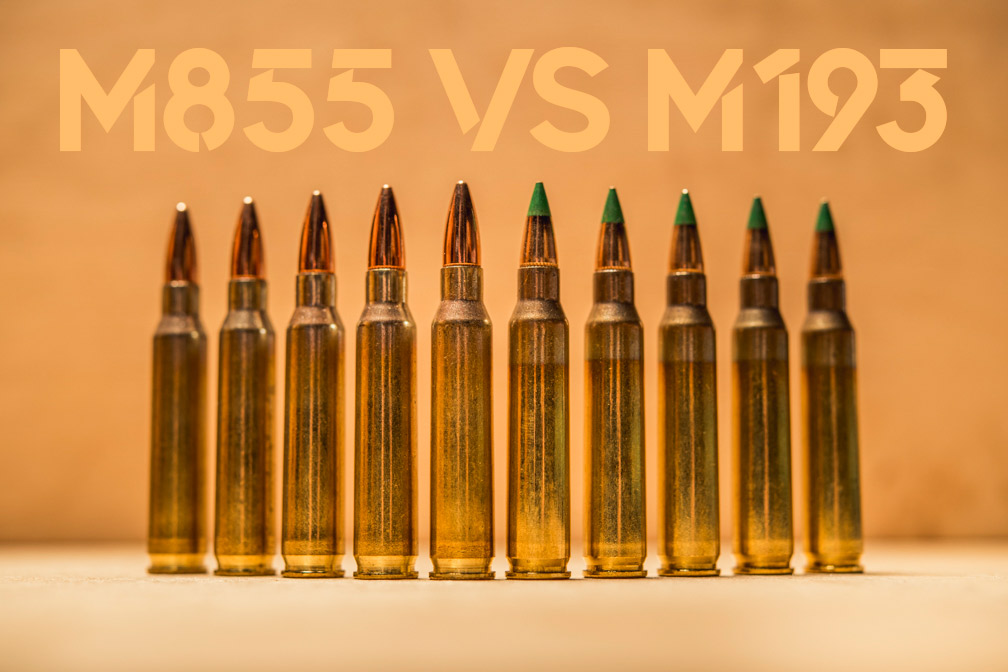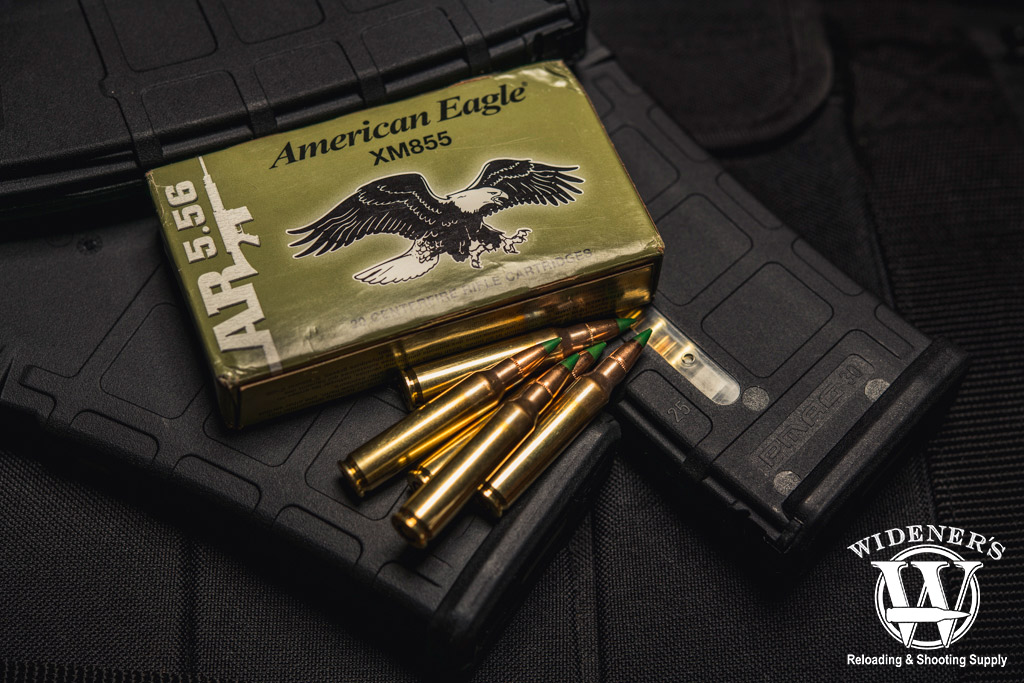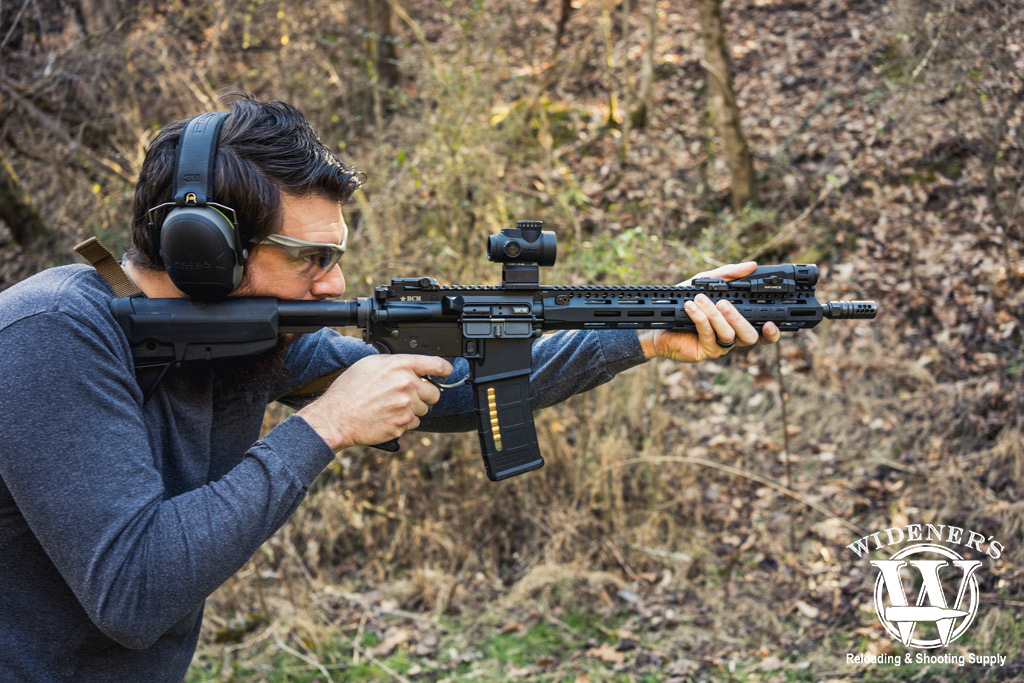

You probably already own a host of firearms chambered in 5.56x45mm NATO. This popular cartridge was first developed in the 1970s by FN Herstal for the M-16 battle rifle used during the Vietnam War. The AR-15 rifle, which is the civilian version of the M-16, also takes advantage of this popular chambering. Today, the civilian AR-15 rifle continues to have the highest production rate of any firearm using this caliber.
One of the debates that often crops up among shooters is which of the two most popular cartridges, the M855 VS M193 is better. While both of these 5.56x45mm NATO cartridges are affordable, available, and reliable, neither performs above average. They are widely considered “general-purpose” loads and their performance is usually enough to keep the average shooter satisfied.
What Is M855 Green-Tip Ammo?

The green tipped 62gr M855 bullet was designed to perform in rifle barrels with faster twist rates.
Easily identifiable by its green-colored nose, the M855 cartridge is designed to improve long-range performance and penetration. The 62-grain full metal jacket boat tail projectile is relatively long for its weight and requires a faster twist rate for proper stabilization toward the target. (Barrels with a 1:7 or 1:8 twist work well with M855). Primarily because of its ability to penetrate, M855 has served as the standard ball ammunition of NATO countries, including the United States, since 1982.
Even though M855 ammo is not armor-piercing, it does penetrate thin-gauge metals, thick clothing, and brush cover very effectively. The green-tipped M855 bullet has a copper jacketed 80% lead core with a 7gr steel tip. The ammo penetrates so well that it devastates steel targets and protective backdrops, resulting in it being banned from many firing ranges.
However, the ammo will not typically break through brick or any of today’s body armor, and ground troops in Iraq were reportedly frustrated that M855 ammo could not penetrate auto glass, even at short distances.
M855 Ammo For Self-Defense?
Those features that allow the M855 ammo to power through many barriers also make it more likely to pass through a soft target without inflicting significant tissue damage. The tougher M855 tends not to fragment and is, in fact, considered a more “humane” combat cartridge. Fragmentation provides more energy and damage within the target than if the bullet had passed straight through, a potential drawback for those purchasing ammo for self-protection or hunting.
Vietnam & Beyond: M193 Ammo
Developed in the 1960s, the M193 is a 55-grain copper-jacketed round (full metal jacket) that was the primary ammo for the M-16 battle rifle. It saw plenty of action in Vietnam and beyond until the M855 replaced it in 1982. While it was reasonably accurate when used with the M-16’s 1:12 twist-rate barrel, the projectile, as one soldier explained it, “sheds velocity faster than a Golden Retriever sheds hair on the living room carpet,” making long-range accuracy a problem.
Another issue is the lightweight grain. It didn’t allow the projectile to cause much damage if it first penetrated light cover, such as thick clothing or the jungle vegetation of Southeast Asia. However, if the M193 round found its target unimpeded, it would often fragment, causing considerable damage inside soft tissue. Unfortunately, fragmentation has never been consistent with M193 loads, and without it, the projectile typically produces minimal wounds.
Comparing M855 VS M193

When comparing M855 VS M193 ammo, it’s important to remember that the cartridges were designed for different purposes.
| Bullet Type | Bullet Weight | Velocity (Muzzle) | Energy (Muzzle) | |
|---|---|---|---|---|
| M855 | FMJ-BT | 62gr | 3,110 FPS | 1,325 FT LBS |
| M193 | FMJ-BT | 55gr | 3,260 FPS | 1,294 FT LBS |
Remember that the difference between the M193 and M855 load is relatively minor. Both are loaded with full metal jacket bullets. The 62-grain M855 is heavier and slightly slower at 3,000 fps muzzle velocity, while the 55-grain M193 leaves the muzzle at 3,250 fps. So the M193 is a lighter round that flies at a higher speed and is unstable when it reaches the target—the tumbling results in more extensive and lethal wounds.
However, the other side of the coin is that fragmentation at impact means the M193 does not have the penetrating power to rip through armor, hardened steel, and many other barriers. Also, it is more affected by wind and drops more significantly at a distance than the M855.
Still, even though the military moved on from the M193 doesn’t necessarily mean you and many other shooters should, too. It has some notable advantages:
- Less expensive to buy and use for training
- Hunters appreciate its terminal effects at shorter distances
- It can be stabilized in a wider variety of twist rates
- Excellent ammo for the firing range, hunting, or as training ammo
Why did the military abandon the M193 in favor of the M855?
After the Vietnam War, relations between the U.S. and the Soviet Union continued to deteriorate. There was increasing concern about the M193’s inability to penetrate Soviet body armor or a Russian soldier’s helmet from several hundred yards.
Firearms manufacturer FN Herstal started working on a new NATO round, and, after years of testing, the United States officially adopted it and named it the M855 to replace the M193. But it wasn’t long before new concerns surfaced as the latest rounds were making clean holes in the enemy during the first Gulf War and in Somalia. The issue of straight-through holes continued until recently, when the military created and adopted the M8551A to address these issues.
Picking A Winner: M855 VS M193

Headed to the gun range? Stock up on M193 ammo before you go, it’s going to be your best option.
Choosing the best ammunition all depends on your needs. Each round has advantages over the other, so unless green is your lucky color, there is no obvious winner. M193 ammo has a long history, but M855 was created to address its performance issues in specific situations. Make your choice by stocking up on the cartridge that is most well suited for your needs.
From comparing M855 VS M193, we know the strengths and weaknesses of both cartridges. If penetration, longer distance, resistance to wind, and other environmental factors are important to you, then M855 will suit you better. But if you’re buying ammo for range shooting, hunting, or self-defense, the average, run-of-the-mill (and cheaper!) M193 is a better option.
The M193’s tendency to fragment on impact makes it more ideal for hunting and personal protection. And keeping in mind that many ranges have banned the M855 because it tears up steel targets and protective backdrops. If plinking and training at the range is your intended purpose, stick with the M193 cartridge.


